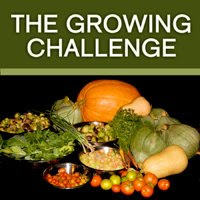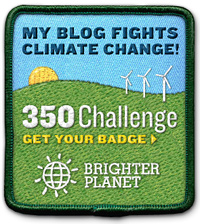I don't usually write about politics. I tend not to even talk much about politics. But did you hear the news? John McCain has selected Alaska Governor Sarah Palin as his running mate. I can't help but contrast her environmental record with hard work Joe Biden has put in over the years. Joe Biden has received a lifetime score of 83% from the League of Conservation Voters. In 2007 alone, Biden voted to strengthen CAFÉ standards and to repeal unjust subsidies to oil companies. In 1986, he introduced the first bill designed to limit global warming pollution. In his own words,
"I personally believe that the single most important step we can take to resume a leadership role in international climate-change efforts would be to make real progress toward a domestic emissions-reduction regime. For too long we have abdicated the responsibility to reduce our own emissions, the largest single source of the problem we face today. We have the world's largest economy, with the highest per-capita emissions. Rather than leading by example, we have retreated from international negotiations."It's hard for me to fathom that there are folks out there who honestly believe that McCain and Palin could possibly be the right choice to lead our country right now, when we are facing problems such as peak oil, global warming and a sliding economy.
-- Jan. 30, 2007, in a statement given before the Senate Environment and Public Works Committee
If you don't already know who Sarah Palin is, here's the scoop I just received in an email from the Defenders of Wildlife Action Fund.
And here's what the League of Conservation Voters has to say about Ms. Palin.FOR IMMEDIATE RELEASE
August 29, 2008
Shocking Choice by John McCain
WASHINGTON-- Senator John McCain just announced his choice for running mate: Governor Sarah Palin of Alaska. To follow is a statement by Rodger Schlickeisen, president of Defenders of Wildlife Action Fund.
“Senator McCain’s choice for a running mate is beyond belief. By choosing Sarah Palin, McCain has clearly made a decision to continue the Bush legacy of destructive environmental policies."
“Sarah Palin, whose husband works for BP (formerly British Petroleum), has repeatedly put special interests first when it comes to the environment. In her scant two years as governor, she has lobbied aggressively to open up the Arctic National Wildlife Refuge to drilling, pushed for more drilling off of Alaska’s coasts, and put special interests above science. Ms. Palin has made it clear through her actions that she is unwilling to do even as much as the Bush administration to address the impacts of global warming. Her most recent effort has been to sue the U.S. Fish and Wildlife Service to remove the polar bear from the endangered species list, putting Big Oil before sound science. As unbelievable as this may sound, this actually puts her to the right of the Bush administration. [my emphasis]
“This is Senator McCain’s first significant choice in building his executive team and it’s a bad one. It has to raise serious doubts in the minds of voters about John McCain’s commitment to conservation, to addressing the impacts of global warming and to ensuring our country ends its dependency on oil.”
08/29/08
FOR IMMEDIATE RELEASE
Choice of Palin Promises Failed Energy Policies of the Past
WASHINGTON, D.C. – The League of Conservation Voters (LCV), which works to turn environmental values into national priorities, today expressed its deep disappointment with John McCain's choice of Sarah Palin as his running mate.
“Unfortunately, with her support for drilling in the Arctic Refuge and off our coasts, Governor Palin will simply continue the failed policies of the Bush-Cheney Administration and their Big Oil friends – policies that could make us even more dependent on foreign oil," LCV President Gene Karpinski said.
Governor Palin characterizes McCain’s flip-flop on drilling offshore as a positive step in his transformation from maverick to Big Oil's best friend. She has implored McCain to change his position against drilling in the Arctic – something she will have plenty of opportunities to pursue as his running mate.
In addition to supporting backward-looking energy policies, Governor Palin has also opposed a crucial clean water initiative, sued the federal government for listing polar bears as threatened under the Endangered Species Act, and opposed other important wildlife protection measures.This ticket now stands in even starker contrast to the visionary energy plan laid out by Senator Obama last night, which will create millions of new jobs, improve our
national security, and reduce global warming pollution.
“Now more than ever, America is in need of real vision and leadership to bring us a new clean energy future, and the McCain-Palin ticket offers nothing of the sort.”
If there ever was a time to volunteer for a campaign, persuade friends and family to vote, and offer to drive neighbors to the polls, this is it. Please talk to everyone you know, help educate them on the issues, and get out the vote!
I checked it out - Obama gets an 86% lifetime score by the LCV, McCain 24% and Palin is not rated.














